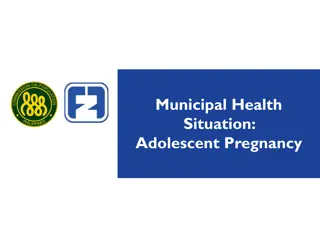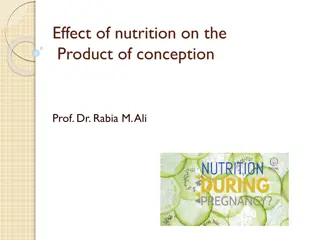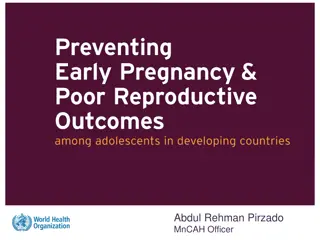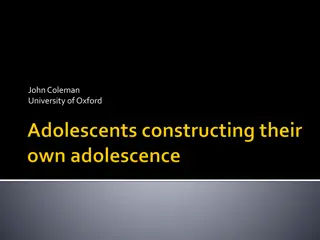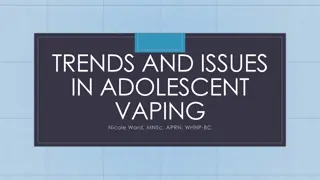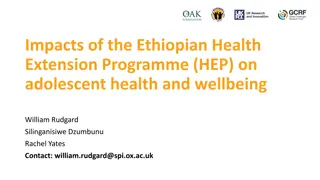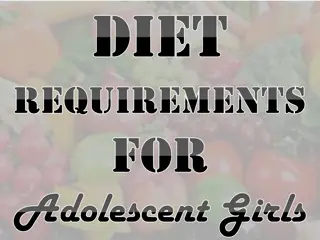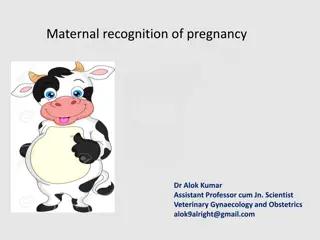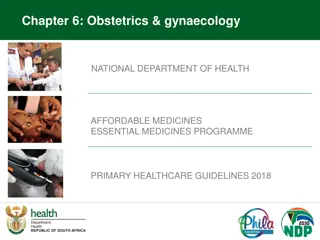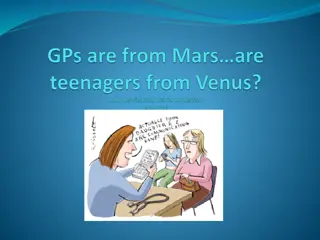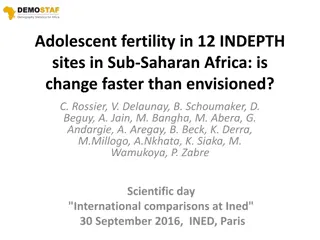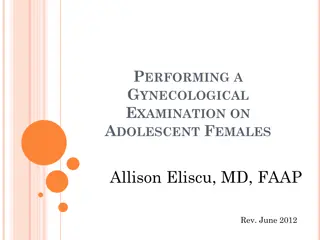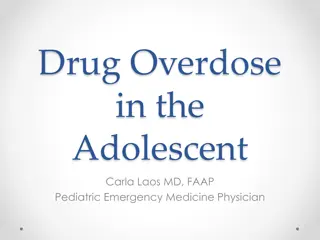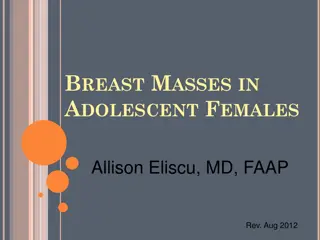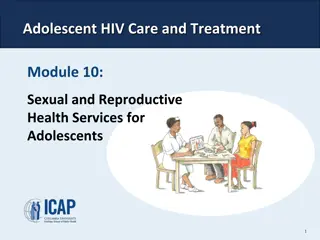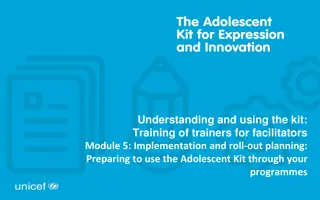Alarming Global Trends in Adolescent Pregnancy
Adolescent pregnancy poses significant health risks to young girls worldwide, with about 16 million aged 15 to 19 giving birth annually. The consequences include increased maternal and infant mortality rates, unsafe abortions, and higher HIV prevalence among pregnant teenagers. Disturbing trends are observed in countries like South Africa, India, and the United States, highlighting the urgent need for comprehensive reproductive health education and support.
Download Presentation

Please find below an Image/Link to download the presentation.
The content on the website is provided AS IS for your information and personal use only. It may not be sold, licensed, or shared on other websites without obtaining consent from the author. Download presentation by click this link. If you encounter any issues during the download, it is possible that the publisher has removed the file from their server.
E N D
Presentation Transcript
ADOLESCENT PREGNANCY
Key facts About 16 million girls aged 15 to 19 and some 1 million girls under 15 give birth every year most in low- and middle-income countries. Complications during pregnancy and childbirth are the second cause of death for 15-19 year-old girls globally. Every year, some 3 million girls aged 15 to 19 undergo unsafe abortions. Babies born to adolescent mothers face a substantially higher risk of dying than those born to women aged 20 to 24.
Adolescent Pregnancy Leads to Unsafe Abortions A study in Nigeria in the early 1990 s, that included about 144 women (half of which were under 20 years of age), reported many complications- including a 9% death rate. Only 25% had no complications. In some urban areas unmarried adolescents represent the majority of all abortion seekers. In developing countries, the risk of death following unsafe abortions is several hundred times higher than one performed professionally in safe conditions. Almost 14% of all unsafe abortions occur in adolescents under the age of 20. The rate is higher in Africa than any other region. Source: WHO (2004)
SOUTH AFRICA The number of pregnant school girls jumped from 1,169 in 2005 to 2,336 in 2006 in Gauteng. One in three girls has had a baby by the age of 20. 16 percent of pregnant women under the age of 20 tested HIV positive. 30 percent of girls in South Africa said "their first sexual experience was forced or under threat of force".
INDIA As per a reports by the UN Statistics Division, estimates are that India has had about 86 cases per 1000 women in the age group of 15-19 years between the years 1995-2010 who have had teenage pregnancies. Cultural constraints push women to have more kids even if they do not want to, and drives them to illnesses and weakness for the rest of their lives.
UNITED STATES One million teenagers become pregnant annually. The United States has the highest rate of teen pregnancy, childbirth and abortion among developed countries 63% give birth, and 22% have abortions. According to the Centers for Disease Control (CDC), teenage pregnancy rates nationally dropped 27 percent overall during the years 1990-2000. Despite the decline, the teenage pregnancy rate in the United States is still the highest among industrialized nations. Even with the drop, 35 percent of U.S. teenage girls become pregnant at least once before age 20.
For some adolescents, pregnancy and childbirth are planned and wanted, but for many they are not. Adolescent pregnancies are more likely in poor, uneducated and rural communities. In some countries, becoming pregnant outside marriage is not uncommon. By contrast, some girls may face social pressure to marry and, once married, to have children. More than 30% of girls in low- and middle-income countries marry before they are 18; around 14% before they are 15. Some girls do not know how to avoid getting pregnant: sex education is lacking in many countries. They may feel too inhibited or ashamed to seek contraception services; contraceptives may be too expensive or not widely or legally available. Even when contraceptives are widely available, sexually active adolescent girls are less likely to use them than adults. Girls may be unable to refuse unwanted sex or resist coerced sex, which tends to be unprotected
Factors leading to Teen Pregnancy Lack of proper sex education: Though we claim to be a modern country, talking about sex still remains a taboo. So, yes, schools are now providing sex education but they do it just for the sake of doing and not with the aim to counsel properly Poverty: Teens don t even get the chance to get educated Child marriages: This social evil just refuses to fade away in India. Young girls are married off and they get pregnant at a tender age of 15 or 16 Nuclear families: Lack of guidance from elders of the family Peer pressure: Teens hear their friends doing it without getting pregnant and they want to try it too otherwise their friends will call them cowards of not having the courage to take risks Exposure to media: There is no filtration of the obscene contents. They see the heroes and heroines do it and so they want to do it too Drinking and smoking: Abuse of drugs make them loose conscious of what s right and wrong
Lack of supportive parents and family: A child deprived of love will look for pleasure and happiness elsewhere Exposure to sexual violence: Sexual abuse at home. Unhealthy environment at home Stressful lifestyle: A depressive lifestyle can always lead an individual to look out for something which in which they will find momentary pleasure
A matter of Human Right Early pregnancy and motherhood are closely linked to issues of human rights. A pregnant girl who is pressured or forced to leave school, for example, is denied her right to an education. A girl who is prevented from accessing contraception or reproductive health information is denied her right to health. In every region of the world - including high-income countries - girls who are poor, poorly educated or living in rural areas are at greater risk of becoming pregnant than those who are wealthier, well-educated or urban. This is true on a global level, as well: 95 per cent of the world s births to adolescents (aged 15-19) take place in developing countries. Every year, some 3 million girls in this age bracket resort to unsafe abortions, risking their lives and health. Girls who lack choices and opportunities in life, or who have limited or no access to sexual and reproductive health care, are more likely to become pregnant. Girls forced into child marriage a violation of their human rights are also more likely to become pregnant. In developing countries, nine out of 10 births to adolescent girls occur within a marriage or a union.
Health Effects Pregnancy and childbirth complications are the second cause of death among 15 to 19 year olds globally. However, there have been significant drops in the number of deaths in all regions since 2000, most notably in South-East Asia where mortality rates fell from 21 to 9 per 100 000 girls. Some 3 million unsafe abortions among girls aged 15 to 19 take place each year, contributing to maternal deaths and to lasting health problems. Early childbearing increases the risks for both mothers and their newborns. In low- and middle-income countries, babies born to mothers under 20 years of age face a 50% higher risk of being still born or dying in the first few weeks versus those born to mothers aged 20-29. The younger the mother, the greater the risk to the baby. Newborns born to adolescent mothers are also more likely to have low birth weight, with the risk of long-term effects.
Economic and Social Effect Adolescent pregnancy can also have negative social and economic effects on girls, their families and communities. Many girls who become pregnant have to drop out of school. A girl with little or no education has fewer skills and opportunities to find a job. This can also have an economic cost with a country losing out on the annual income a young woman would have earned over her lifetime, if she had not had an early pregnancy.
WHO RESPONSE WHO published guidelines in 2011 with the UN Population Fund (UNFPA) on preventing early pregnancies and reducing poor reproductive outcomes. These made recommendations for action that countries could take, with 6 main objectives: reducing marriage before the age of 18; creating understanding and support to reduce pregnancy before the age of 20; increasing the use of contraception by adolescents at risk of unintended pregnancy; reducing coerced sex among adolescents; reducing unsafe abortion among adolescents; increasing use of skilled antenatal, childbirth and postnatal care among adolescents.
REFERENCES http://www.cnn.com/2013/10/30/world/un-teen-births/ https://www.unfpa.org/sites/default/files/pub- pdf/ADOLESCENT%20PREGNANCY_UNFPA.pdf http://www.ncbi.nlm.nih.gov/pmc/articles/PMC3372345/ http://www.who.int/mediacentre/factsheets/fs364/en/ http://www.beingtheparent.com/causes-and-effects-of-teenage- pregnancies/ http://blogs.wsj.com/indiarealtime/2013/10/30/in-india-teen-pregnancy- extremely-likely/ http://articles.economictimes.indiatimes.com/2008-11- 14/news/27699809_1_pregnant-teens-teen-pregnancy-family-planning http://www.unfpa.org/adolescent-pregnancy


